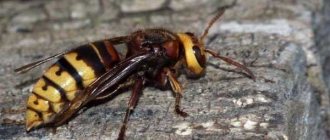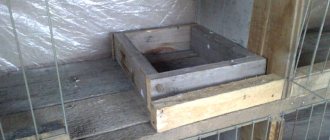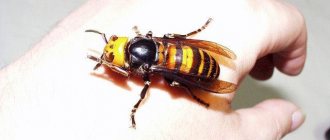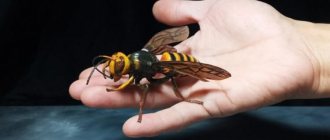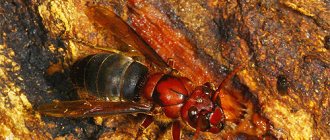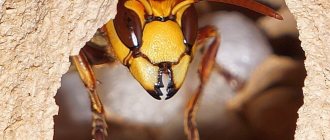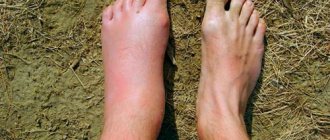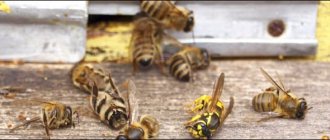Most summer residents or beekeepers are well acquainted with such an unsafe flying insect as the hornet. This winged predator inflicts very painful bites, which lead to severe swelling, prolonged, twitching pain, allergic reactions, and in some cases, even anaphylactic shock.
Information about hornet nests is divided into the following sections:
- What is a hornets nest?
- Why do you need to get rid of hornets' homes?
- How to find a hornet's home?
- How to best get rid of a hornet's nest
- Photo of a hornets nest
However, hornets are not considered as aggressive and annoying as their close relatives, wasps. They attack a person only when they feel a threat from him to their nest, which is better not to approach closer than 50 meters.
Important:
Located in the structures of outbuildings, it poses a constant threat to people. That is why you need to be able to find these nests and carefully get rid of them.
How dangerous is a hornet?
The main danger of the hornet lies in its rapid attacks, often in multiple bites, sometimes accompanied by serious allergic reactions.
Being a predator, the insect nevertheless produces a flower product, which, during the ripening process, becomes very similar to classic honey. It is quite edible, healthy and even tasty. Thus, it cannot be said that hornets do not make honey at all, but its amount is so insignificant that there is no need to talk seriously about hornet honey.
Adult
Equipment and first aid
Hornets have a long and sharp sting that can pierce even thick denim fabric. A person planning to approach the nest should protect himself by wearing a protective suit. These are what beekeepers wear when they pump out honey. Cover your face with a helmet with a net.
You will need thick, long gloves, because a person allergic to hornet venom only needs one bite to cause Quincke's edema or anaphylactic shock. What to do if there is no special suit? Put on several pants, a thick jacket and a sweater, wrap your neck with a thick scarf, without leaving even small gaps. Find an old hat and attach a piece of curtain to it, turning it into a makeshift protective helmet.
Wear rubber boots or high winter boots on your feet. No flip flops or sandals. The pants are tucked into socks and then into boots so that predatory insects do not have access to the body.
Before starting the operation, consider retreat options. Perhaps place a barrel or iron bathtub filled with water in the yard. A person attacked by hornets will be able to jump into a container of liquid and hide for 30–40 seconds. This is often enough for the angry guards to retreat.
A person who has been stung by a hornet needs first aid. Act quickly to stop the poison from spreading throughout the body, so have the following on hand:
- a bottle of peroxide, ammonia or calendula tincture;
- packaging of an antihistamine, such as “Suprastin” or “Diazolin”;
- roll of cotton wool;
- a bowl of ice wrapped in cloth.
A cotton swab soaked in an alcohol-containing solution is applied to the bite, and the victim is given an antihistamine tablet to prevent anaphylactic shock. Ice is then applied to the swollen soft tissue to stop the swelling from spreading.
How do hornets build nests?
It is always the queen who lays the nest and builds the first comb. With the arrival of worker bees, she delegates this responsibility to them.
The building material is tree bark, which the hornets carefully chew with their strong jaws to a pulpy state. From the resulting material, insects build their home, constructing it layer by layer, from top to bottom. A fairly powerful protective wall, up to 8 mm thick, is made around the nest, forming a dense light gray cocoon with vent holes.
Under natural conditions, hornets build their nests in tree hollows or earthen burrows. Having become neighbors of a person, they choose some secluded place, protected from wind, rain and sunlight: an attic, a chimney, a barn, etc.
Having invested a lot of effort into the construction of their house, the hornets use it for only one year. The following spring, the queen who has survived the winter begins building a new home from scratch.
Construction process
The way the hive construction process is carried out surprises everyone - the insects put in a lot of work, discipline and self-organization. They try to make their own home as comfortable and durable as possible, capable of protecting them from hot and cold weather conditions.
The choice of material that serves as the basis of the nest is also interesting - they use wood and bark. They especially fell in love with birch, which is why their buildings have a lighter shade than those of wasps or bees. They carefully chew pieces of wood, moistening them with saliva - the resulting material allows them to sculpt honeycombs, walls, partitions and shells.
The choice of a place for construction is made by the queen, who begins the construction of the future house. Initially, she begins to sculpt the first ball of cells, where she lays eggs. After about a week, the eggs hatch into larvae, which after 14 days turn into pupae. After another two weeks, the nests are replenished with young workers, continuing the construction of housing.
The number of insects that will develop in the season also depends on the level of productivity of the new generation. After the worker hornets fly out, eggs of future females and males are laid. Since emergence begins at the sexually mature stage, swarming occurs immediately after this.
How many hornets live in a nest?
The number of hornets in a nest depends on many factors and ranges from 400 to 600 individuals, although there are cases when the number of insects in one nest reached 1000.
Hornet larvae emerge from eggs laid by the female on the 5th...7th day. Their development lasts 10-15 days, ending at the pupal stage. After 1.5-2 weeks, a young individual emerges from the pupa. The colony reaches its maximum by the end of summer - beginning of autumn.
"House"
Traps
Various types of insect traps have become very popular; stores offer a wide range of similar products.
But you can make them yourself without much difficulty:
- Take a plastic bottle with a volume of at least 1.5 liters and cut off the top neck.
- Pour aromatic bait into the prepared container, which will attract the wasp family - jam, honey, beer are suitable for this - it is best to mix these ingredients.
- Insert the top of the bottle into the main part, so that the neck faces the bottom. But don't forget to remove the cover.
- As an additional measure, lubricate the neck with oil.
Hornets will fly into such a ready-made trap, after which they will not be able to get out. And if some of the individuals are able to get to the neck, they will still not be able to get out, since it will have a slippery coating.
Traps are prohibited from being used in only one case - when a bee apiary is located near the site.
Methods for destroying nests
There are quite a few ways to destroy hornet nests. But the main thing, when starting Operation Liquidation, is to take care of personal protective equipment.
- One of the accessible and effective ways to destroy a hornet nest is a bucket of diluted kerosene or boiling water . The discovered cocoon is immersed in it without disturbing it. The liquid should completely cover the socket. After 24 hours, all its inhabitants die, and the cocoon itself most often ends up in a bucket.
- Aerosols to combat flying insects help solve the problem of destroying hornets within a few minutes. You need to work in a protective suit with a respirator. To consolidate the result, you can re-process.
- Insecticidal preparations in powder form have proven themselves well in cases where the nest is located in a hollow tree. The poison is left inside, and some time later, when the hornets become lethargic or die, the entrance to the hollow is sealed with foam or gypsum mortar.
- also treat polyurethane foam If all entrances and exits are properly sealed, the insects inside the nest will simply die of starvation.
- A quick and effective way to destroy even a huge hornet nest is to use smoke bombs . Experts advise using a sulfur bomb after placing it in a metal container.
- Fire is the most radical way to get rid of dangerous insects. The hornets' nest is doused with flammable liquid and set on fire. Compliance with fire safety measures is mandatory.
- A hive that is built in the ground or in an old stump can be destroyed using a large amount of boiling water .
- In cases where the cocoon is in a hard-to-reach place, bait and poison . First you need to accustom the insects to eating in the same place using bait, and then start adding poisonous substances there. Working hornets will not only poison themselves, but will also poison the queen and their other relatives by bringing poisoned food to the nest.
Smoke bomb
- If you manage to find a nest that has just begun to form, you can destroy it by placing a rag soaked in ammonia . The queen will die and new hornets simply will not appear.
- A life hack with a vacuum cleaner is also perfect. The end of the suction hose is placed inside the nest, and all the insects end up in the bag or container of the vacuum cleaner. It is better to shake them out after two days, making sure that the insects are dead.
On a note! It is recommended to destroy hornets in the evening or even at night, when the entire family is assembled and its activity is minimal. It is advisable not to use a bright light source.
When insects fly out of the hive
At the end of autumn, the home begins to gradually empty. If you want to figure out when representatives of the wasp family leave the hive, you need to clarify certain nuances.
The death of males begins almost immediately after swarming. With the onset of cold weather, the death of workers and the queen begins. At this time, a search is carried out for a suitable secluded and warm place for wintering by fertilized females.
With the beginning of the autumn period, the female begins to produce a special substance, which in winter frosts is a kind of antifreeze that prevents their body from freezing during the period of suspended animation. Trees, hollows, and outbuildings serve as temporary housing. Some of the individuals may overwinter inside the old hive.
Only a small percentage of insects can survive the cold calmly. From the moment of the first warm days, females leave their temporary shelter and look for a suitable place to start establishing a new cocoon. Interestingly, hornets do not settle in old nests and always start building a new house.
Taking into account behavioral characteristics and differences in the life cycle, the optimal period for removing hives is the end of autumn, winter. This time is characterized by the absence of huge wasps in them, so there is no risk of being attacked by them. The nests are easily removed if you file down the base, then you need to burn it.
If a bird has built a nest on the balcony: what does the sign promise?
People have always believed that if a bird undertakes to hatch its offspring under the roof of a house, then its residents are under the protection of higher powers. If birds have built a nest on the balcony, the omen is interpreted in the same way - the residents of the apartment have nothing to fear, nothing bad or tragic will happen in their lives in the near future.
A dove's nest promises harmony in the family, complete mutual understanding among household members, peace and friendship with neighbors.
Swallows have built a nest on the balcony - a sign indicating that the residents of the apartment have received a living talisman against troubles and failures
There is no need to be afraid of thieves, fire, household gas explosions and other misfortunes.
Sparrows have built a nest - for an imminent important event that will gather many guests. The event will be noisy, cheerful, like a crowd of restless sparrows
Most likely, it will be a wedding, or maybe a grandly celebrated anniversary, the birth of a baby, or retirement.
Tit. If a tit builds a nest on the balcony, the omen promises financial stability and well-being, a promotion and career advancement.
Wagtail. It is very rare, but it still happens to come across a wagtail nest on the balcony - such an event promises good luck in any endeavor.
Don't ruin
In order not to frighten away luck and not to turn a positive omen into a negative direction, you should not destroy nests, throw them away and drive away the bird. Wait patiently until they breed and fly away - this will happen around the fall. When the birds leave their home, you can dismantle it if you want. Or leave it - then it will continue to perform its protective and protective functions.
Calling specialists
This method is the safest, since employees will independently carry out the work with a high level of efficiency.
This option has some features that need to be taken into account:
- Now there are many companies that specialize in pest control, but you should not choose the first one you come across, you need to compare the presented options according to the criteria of pricing policy and customer reviews,
- Before work, important aspects need to be discussed, including a guarantee that the hornets will not reappear - such information must be included in a written contract,
- This problem most often occurs in suburban areas, which also affects the cost of the service.
If you want to destroy a nest and fight hornets, consider whether there is a real threat to people living in the area or bees in the apiary. Since an insect of this species benefits nature, and some of the species are listed in the Red Book as endangered.
